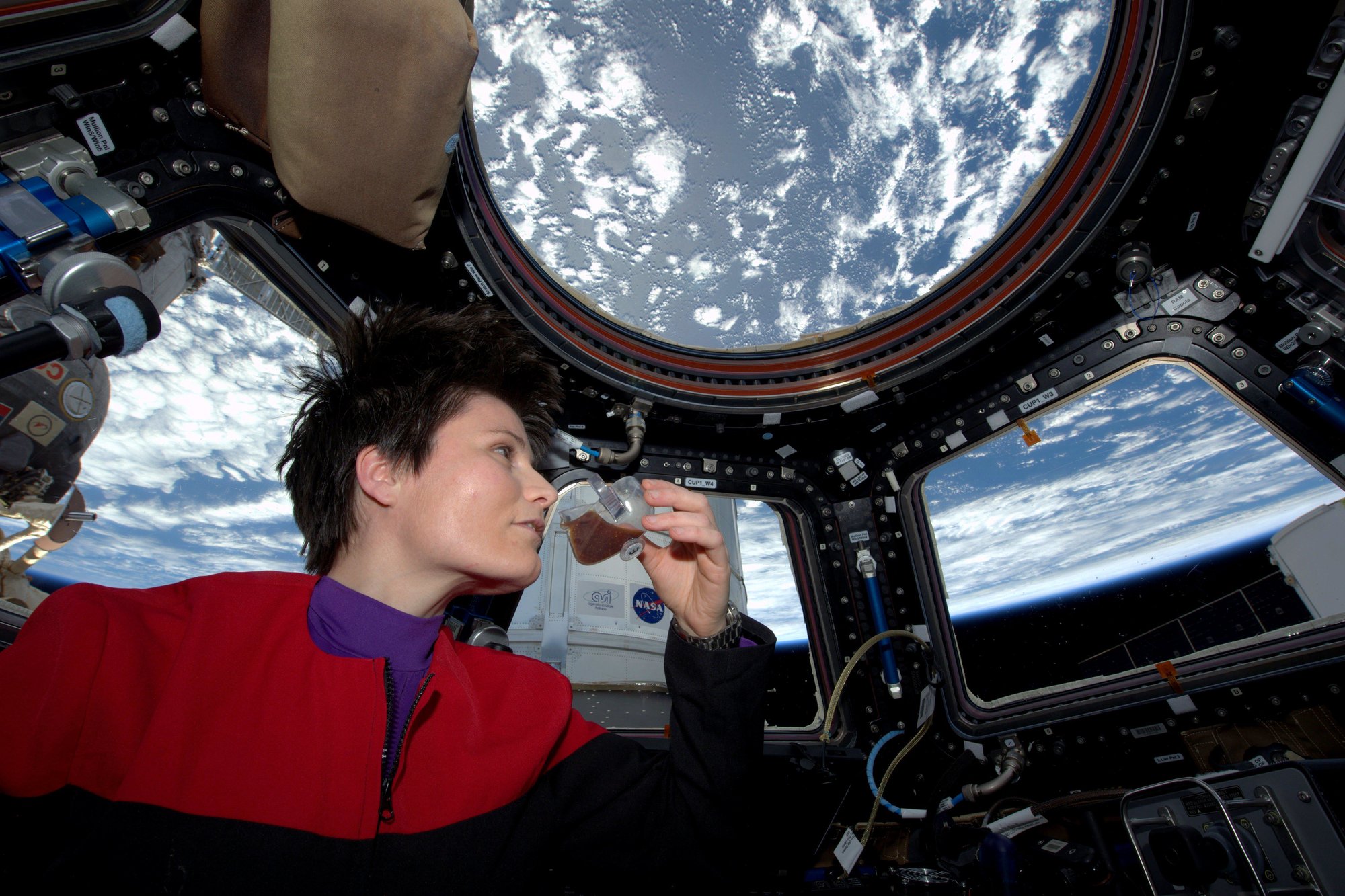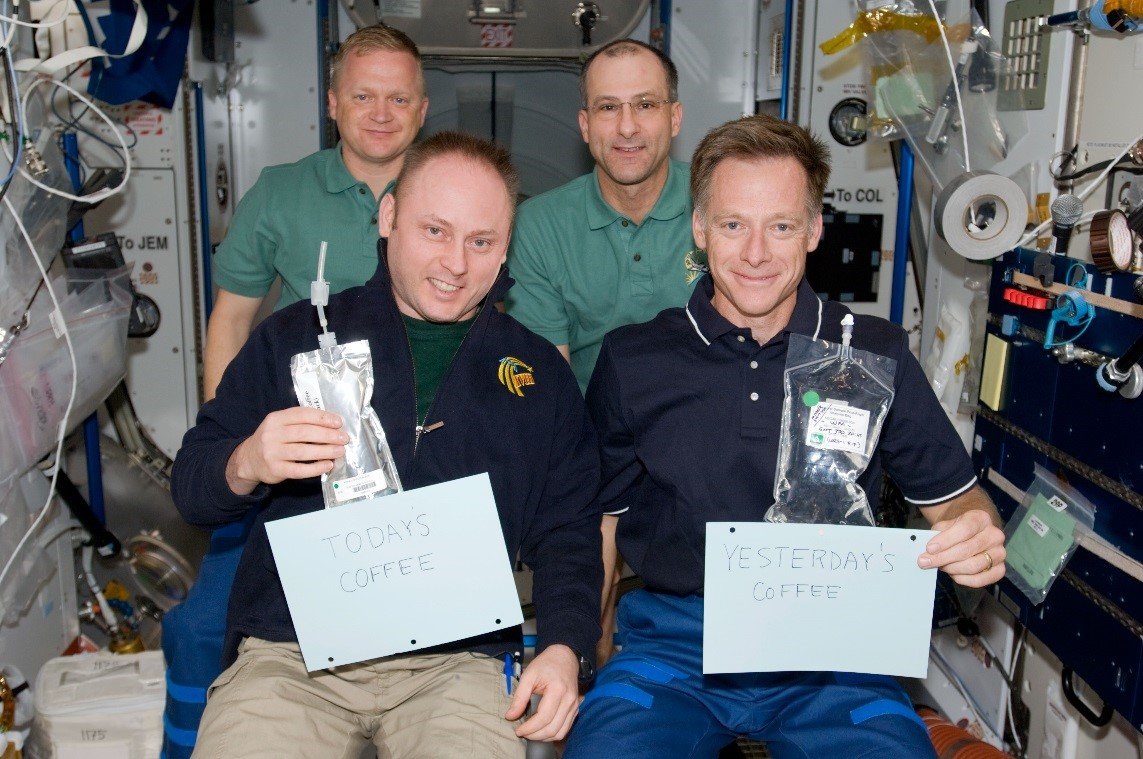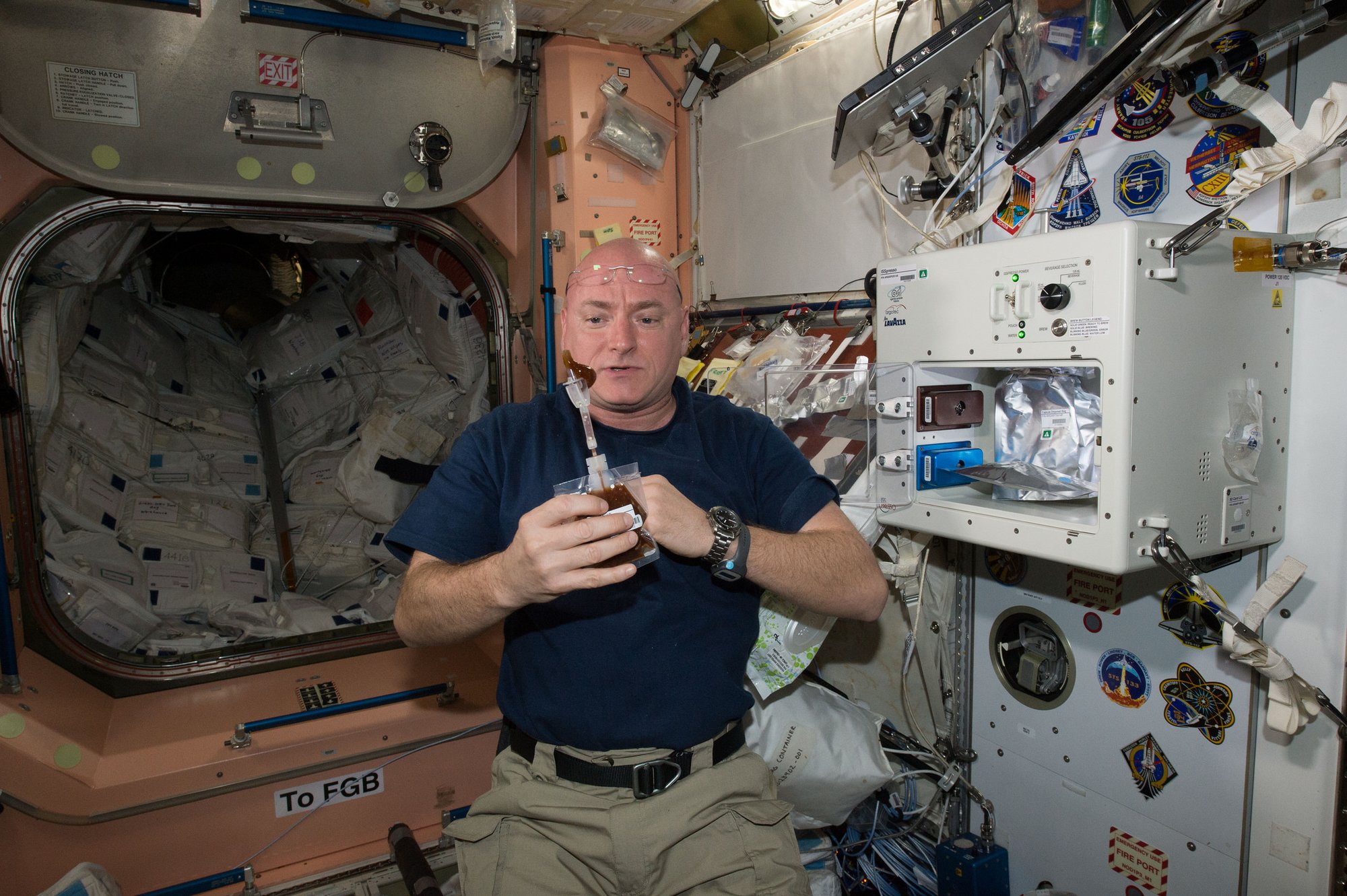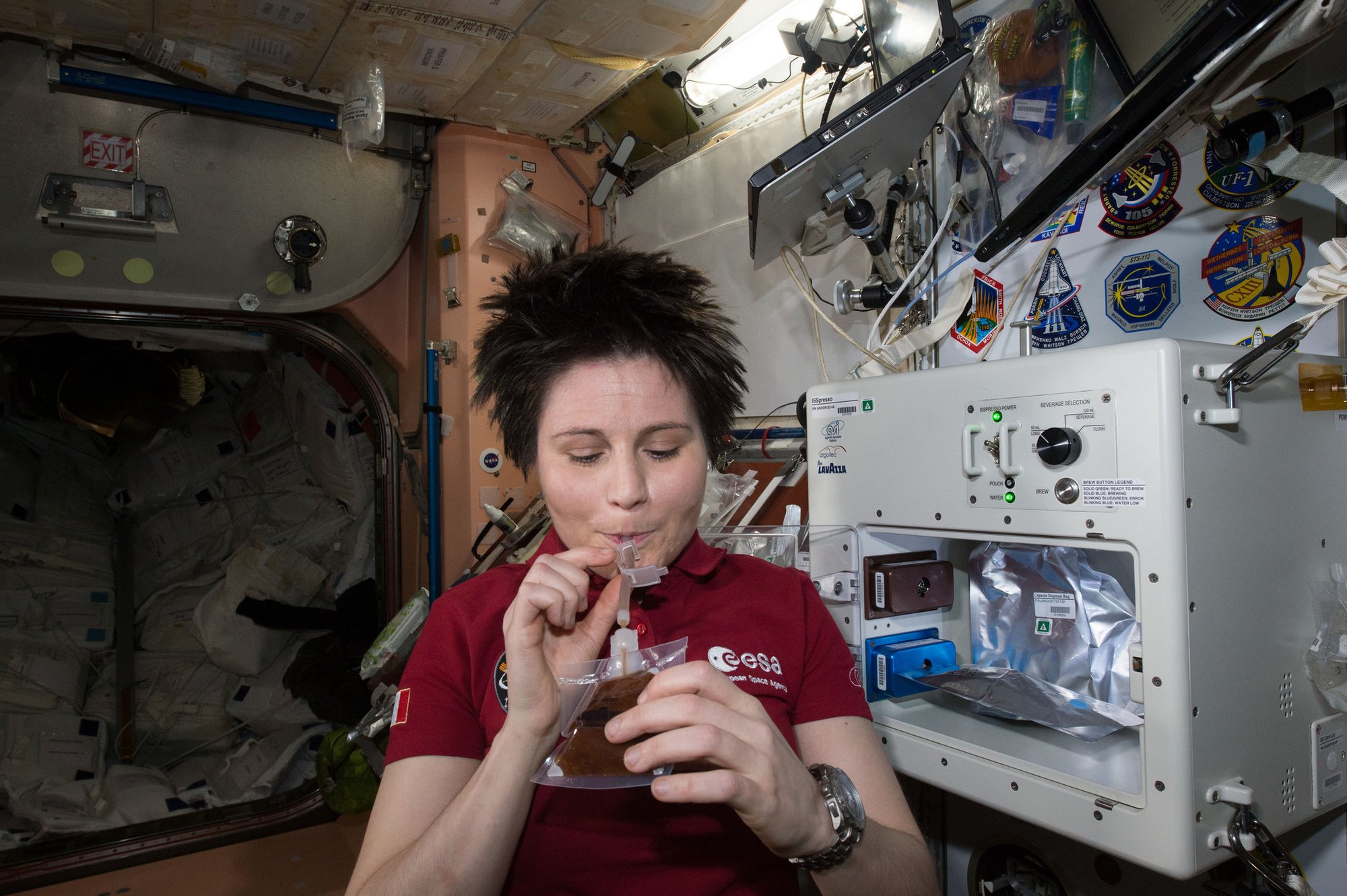
European Space Agency astronaut Samantha Cristoforetti sips espresso from the space cup, which was designed to study the capillary effects of drinking in microgravity. NASA photo.
If the four fundamentals of the perfect cup of coffee are freshness, grind, proportion, and water, then International Space Station astronauts might be drinking the most perfectly engineered espresso ever created by man.
But they didn’t get there overnight.
When Italian astronaut Samantha Cristoforetti went to the ISS, the Italian aerospace engineering company Argotec and Italian coffee maker Lavazza paired with the Italian Space Agency to create the first zero-gravity espresso machine, ISSpresso. But to truly enjoy coffee the way it was meant to be consumed, astronauts and scientists had to keep going.
Along the way, they were able to test heat transfer and fluid dynamics in microgravity and zero-gravity conditions. Fresh, hot coffee was actually just a perk.

In 2008, astronauts on board the International Space Station — Michael Finke and Chris Ferguson, front row from left, with Eric Boe and Donald Pettit — demonstrate the pouch method of drinking coffee. Pettit designed the first rudimentary space coffee cup. Photo courtesy of NASA.
1. Integrating the Aroma
For much of the history of human space travel, coffee had to be “enjoyed” through a vacuum-sealed, airtight plastic bag. If that wasn’t bad enough, it was also the freeze-dried variety. But even ISSpresso was sealed in a bag. On Earth, we take for granted that the smell of coffee is part of the coffee experience. Which means you need an open cup.
Chemical engineer and NASA astronaut Donald Pettit wanted to have his cup of coffee in an open container, not sucked through a straw in a bag. He used his memory of college-level surface chemistry to create a rudimentary zero-gravity cup using a plastic binder divider and some tape (special NASA tape, of course). He formed it into a teardrop shape to create the wetting and surface tension necessary to control the fluid.
After 50 years, astronauts were able to smell their coffee in space.
2. Bubbles in Zero Gravity
The smell of coffee is important, but other parts of enjoying a cup of coffee don’t work the same way in zero gravity. Crema, the brown foam that forms when brewing espresso, is created by the interaction between air bubbles and the natural oil in coffee. Without gravity, the crema either doesn’t form or spreads around the container — or around the floating glob of hot espresso, depending on which cup you didn’t use.
Bubbles do not work the same way in space. When you boil water on Earth, gravity distributes bubbles of steam evenly. In space, they just sit in the liquid and create pockets of scalding hot air — not an enjoyable experience.
To address these concerns, the next form of coffee maker was a hand brewer that brewed coffee through a kind of pour over. The prototype featured a K-cup-style pod placed in a plastic brewer that screwed onto the bottom of a zero-gravity cup. Hot water is forced through the pod through a syringe and into the zero-gravity cup, the next best thing to injecting it directly into your veins.

NASA astronaut Scott Kelly enjoys his first drink from the new ISSpresso machine. The espresso device allows crews to make tea, coffee, broth, or other hot beverages they might enjoy. Photo courtesy of NASA.
3. The Extras
Astronauts are not all that different from the rest of us, aside from their years of training and education in things most of us would struggle to understand. But like all coffee drinkers, everyone has their preferences in brand and taste. How does an astronaut (who may not be down with espresso) get cream and sugar in their brew?
Coffee for astronauts is freeze-dried, but it’s nothing like the instant freeze-dried stuff you’ll find on grocery store shelves. Another difference between us average Americans and astronauts is we don’t have teams of engineers catering to our culinary whims. If space-faring ISS crew members want a specific cup of joe, they can request it and have it freeze-dried in the way that any ol’ NASA coffee is prepared.
Once ground, the coffee is “brewed” with steam to form a concentrate and is then broken down into uniform particles. Moisture is removed from the concentrate in a vacuum, then the concentrate is packed, sealed, and shipped to NASA. NASA puts the concentrate into its vacuum-sealed individual pouches for later consumption.
Any sugar or cream will need to be broken down in the same way as the coffee concentrate. It won’t be perfect because cream and sugar have to be added in specific ratios, but it’s better than nothing.

European Space Agency astronaut Samantha Cristoforetti enjoys her first drink from the new ISSpresso machine. The espresso device allows crews to make tea, coffee, broth, or other hot beverages they might enjoy. Photo courtesy of NASA.
4. The Coffee Mug
After Donald Pettit created his makeshift mug, Mark Weislogel, a fluid physicist at Portland State University, developed a prototype open cup using Pettit’s first-gen cup as a starting point. The problem with a regular coffee cup in space is that the fluid will likely stay at the bottom of the cup and never get to the drinker’s mouth. Surface tension rules in space, and liquid surfaces get sticky — not using a cup would create burning hot blobs of caffeine floating around the station.
The space coffee cup’s design uses fluid dynamics to force liquids to pile up at the cup’s lip and keep it moving using surface tension and the cup’s own shape, which wouldn’t work on Earth. Astronauts have been experimenting with how fluids move along surfaces for decades, but capillary flow experiments exploring how fluids (specifically, coffee) move through narrow passages aboard the station led to the cup’s development.
While the drive for coffee inspired some of these experiments, learning how fluids move in zero gravity is essential for continued advances in spaceflight. Ships, space stations, and (presumably) X-Wing fighters will still need to consume — and dispose of — fluids as they traverse the ether.
This article first appeared in the Summer 2022 print edition of The Forward Observer, a special publication from Coffee or Die Magazine, as "Keeping Astronauts Caffeinated."
Read Next: How East Germany Solved a Coffee Shortage

Blake Stilwell is a traveler and writer with degrees in design, television & film, journalism, public relations, international relations, and business administration. He is a former US Air Force combat photographer with experience covering politics, entertainment, development, nonprofit, military, and government. His work can be found at We Are The Mighty, Business Insider, Fox News, ABC News, NBC, HBO, and the White House.
BRCC and Bad Moon Print Press team up for an exclusive, limited-edition T-shirt design!
BRCC partners with Team Room Design for an exclusive T-shirt release!
Thirty Seconds Out has partnered with BRCC for an exclusive shirt design invoking the God of Winter.
Lucas O'Hara of Grizzly Forge has teamed up with BRCC for a badass, exclusive Shirt Club T-shirt design featuring his most popular knife and tiomahawk.
Coffee or Die sits down with one of the graphic designers behind Black Rifle Coffee's signature look and vibe.
Biden will award the Medal of Honor to a Vietnam War Army helicopter pilot who risked his life to save a reconnaissance team from almost certain death.
Ever wonder how much Jack Mandaville would f*ck sh*t up if he went back in time? The American Revolution didn't even see him coming.
A nearly 200-year-old West Point time capsule that at first appeared to yield little more than dust contains hidden treasure, the US Military Academy said.












